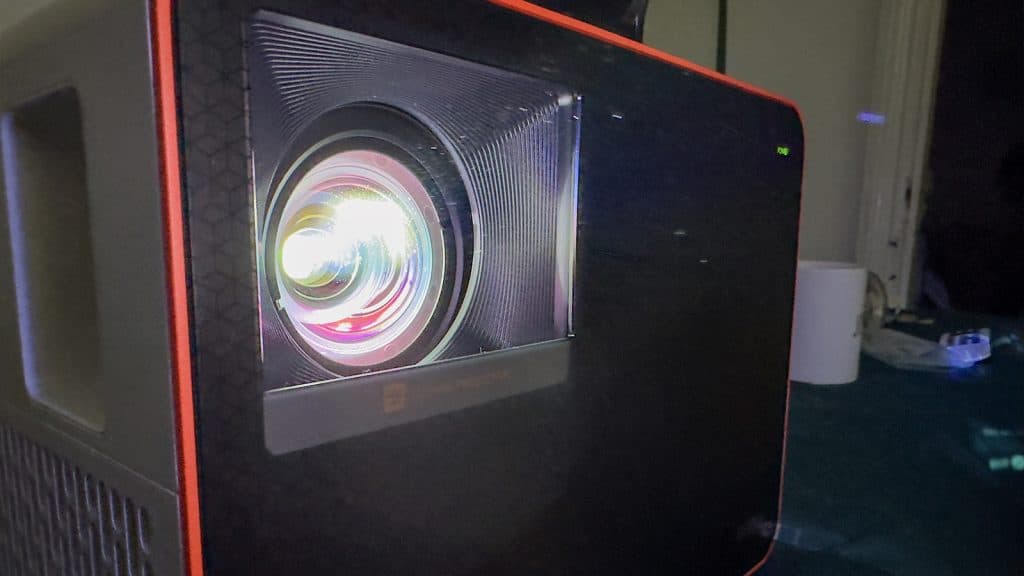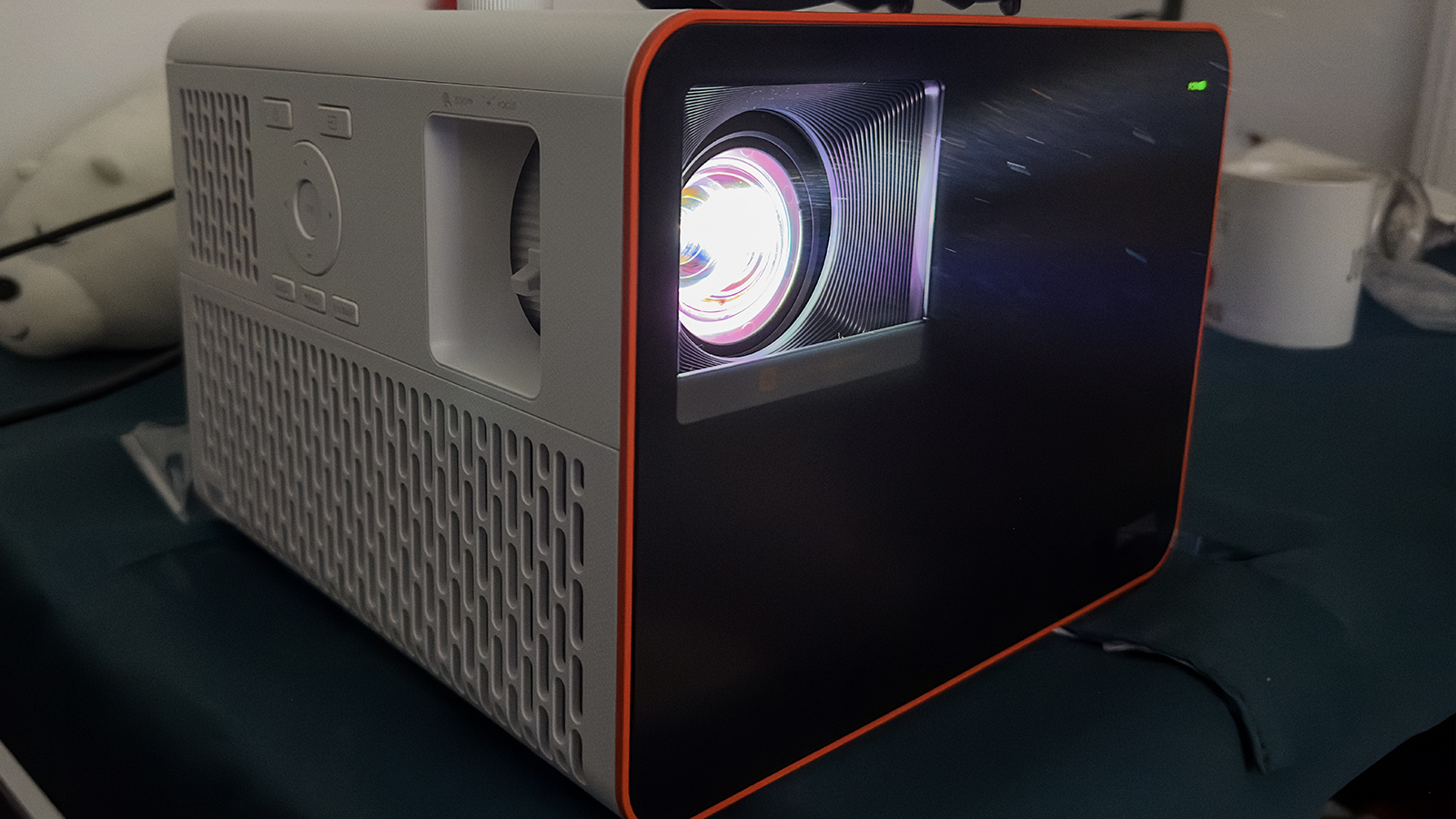The BenQ X3100i gaming projector poses an interesting question for $2399, but does its performance also match the price tag?
Projectors and gaming aren’t always something that goes hand-in-hand. Massive latency issues and running the device for too long could have detrimental effects.
So when BenQ sent over the X3100i gaming projector, of course, I was skeptical. I’d already worked with projectors before and even reviewed one for Dexerto. We covered the previous version of this projector, BenQ has opted to put out an iterative release that still poses a question that I’ve had since it launched the original model.
Key specs
- Native Resolution: 4K UHD (3840×2160)
- Max refresh rate: 240Hz at 1080p
- Color: DCI-P3 100%, Rec. 709 95%
- Throw ratio: 1.15 – 1.50
- Zoom ratio: 1.3x
- Light source: 4LED
- Brightness: 3000 ANSI lumens
- Dimensions: 10.7×7.8×10.2 (inches)
- Weight: 14.1lbs
Setup
This has been one of the more grueling setup processes I’ve ever been through for a projector. You don’t realize how good you have it until you’re forced to manually do things. With the XGIMI projector we previously reviewed, its use of ISA technology to automatically handle the alignment of the picture has spoilt me.
Projectors use a term called “keystone” to determine how the image will be laid out on your wall or screen. Rather than giving you complete control over the picture, it locks certain angles while adjusting. You can move to the right before it starts adjusting the left side of the image.
It doesn’t help that it never feels like you’re getting the image to sit exactly where you want. Even turning off the automatic safeguards to truly manipulate it, it still feels stiff to manipulate the image to where I wanted it.
Android TV
BenQ has opted to keep its gaming projector free of unnecessary clogs. As such, out of the box, there are absolutely zero smart TV amenities. It’s a raw piece of hardware that’s designed to play games. However, in the box is a small Android TV stick that isn’t required to be installed, but the projector’s setup seems insistent that you do.

It begs the question, why go to the effort to not include it in the projector itself when you’re expecting users to include it anyway? It’s not exactly a difficult thing to do, but mid-setting up the last thing you want to do is track down a screwdriver.
BenQ has fitted a micro USB cable and mini HDMI connector inside the projector’s top layer. It’s a seamless fit, and quick to do as well.
Outside of this, setting up the X3100i is relatively easy and I never really felt the need to dive into any of the more advanced settings to fix things up.
Design

I love the boxy shape of the X3100i. It’s easy to slot into most setups, and equally easy to store it away once you’re done. As I don’t have a dedicated “media center” this came in handy as we moved it out of the way once done.
It has this elegance though, something you don’t see from most gaming-focused products – especially from BenQ. There’s a lack of gaudiness around it, and outside of the emblazoned “GAMING PROJECTOR” on the top, you’d never know its intended purpose.
BenQ has made a great effort to keep the X3100i contained in a small area, and it’s appreciated when there’s limited space. Even the control buttons are on the side so that you don’t accidentally step in front of the projected screen while altering settings, or need to awkwardly move your hand around where you’ve managed to nestle it.
Features
While setting up, I feared that focusing on the projection would be an equal hassle. This isn’t the case, nor is it for zooming in or out. The image can be quickly and incrementally adjusted with two fantastic feeling dials on the side. They’ve got this heaviness to them that prevents them from speeding past the perfect point but is light enough to be done with a gentle push.
Gaming features

As on some of popular – and BenQ’s own – gaming monitors, there are even options for a baked-in reticle for FPS games. It’s not as granular as I’d like, and it also begs the question of who is playing esports titles on a projector. In single-player games, I never found it too difficult to keep tabs on the in-game reticle, so it never really became much of an issue.
Ports and no HDMI 2.1 – still
On the back, the port selection is also good. It even supports RS-232, which uses a VGA input port. While it can’t take in video from retro devices like the MisTer, it can be used for greater remote control over the device itself. Not something that a regular person would ever really have on hand, but still great to see being included, just in case.
There are no HDMI 2.1 ports, however. The projector can display up to 240Hz, but it’s limited to 2.0b, meaning the full power of modern HDMI devices can’t be taken advantage of. Where it falters in its gaming prowess is the lack of inclusion for DisplayPort, which would have been a massive boon.

As most of the devices I used on the X3100i were PCs – Steam Deck, a laptop, and Ayaneo 2S – it felt like BenQ missed a trick here. DisplayPort would have allowed for better support of non-console systems. There’s no USB-C either, making docking something like the Ayaneo 2S more of a chore.
This is the second iteration of this particular projector, and to not include HDMI 2.1 as it becomes more prevalent seems like a poor decision.
Color

The X3100i does have the option to adjust lighting and color based on the environment. This is fine on a device like a phone. However, when watching a movie or playing a game and seeing the entire color palette get worse as the sun crept into the room, it’s distracting, to say the least.
With BenQ monitors in the past, my main complaint has always been the color situation. It almost always feels like it’s off in some capacity. Here, I had no such complaints. Colors looked fairly accurate on the wall, and videos or movies felt consistent too. Even in games, nothing ever stood out as “wrong” or “off”. It was a fairly flawless look.
HDR
Using media that was selected to try this – on PC, Xbox, and through Android TV – it was hit and miss. Blacks felt too light, while whites managed to be the correct level of eye-searing. It does have a peak brightness of 3000 nits, and I do believe on PC that Windows’ HDR shenanigans could have foiled some tests. However, no matter the setting, I couldn’t get it to sit as accurately as SDR or generally colorful images.
Sound
Sound meanwhile, is killer. It felt like it was filling the room. I’d placed the projector at the back of my bedroom, and while lying in bed with it a few feet away, I wouldn’t have guessed. While gaming on it, and sitting close by, neither the projector’s fans nor the extraordinary noise ever felt overwhelming either.
Of course, this was highlighted best in movie watching, as my growing Jellyfin library sounded fantastic across the board.
Gaming performance
The core of the X3100i is gaming and it’s a pretty solid hand at it. In fast-paced titles like Warframe, I never missed a beat as I flew through the various levels. Meanwhile, boomer shooters like Turbo Overkill not only looked spectacular, with those vibrant colors but had no discernable latency either.
This was the main thing that worried me. While the XGIMI is great for movies and TV, it can be a little lackluster for gaming. There’s not enough latency to consider it poor, but enough to make it my last option.
You can push the device to run at 240Hz, which also, looked great. Games like The Finals took full advantage of it, while the Series S let my partner play some Xbox Game Pass titles at 120Hz with no issues.
It’s just that at nearly $2500, the X3100i made me question why. Like, who is this for, really?
Who is the BenQ X31000i for?

I can’t see anyone investing this type of money into a device for esports games, nor is it any better than a TV. Blowing games up to the size of your house’s walls is a novelty, and eventually, you have to deal with the reality. You can’t run a projector for massive lengths of time as the 4LED inside will eventually degrade. It doesn’t matter any claims made by these companies, hardware like this needs to be regularly maintained.
What happens if someone were to have massive sessions of their favorite game multiple days in a row, for weeks on end? The projector is going to eventually burn out. The company, however, claims that the buls will last around 20-30,000 hours. Though, verifying those claims is a tall order.
While the X3100i uses 4LED, rather than a bulb, and it can last a lot longer than usual bulb-based projectors, it’s not “user serviceable“. This means it’d have to go in, get replaced, and be sent back. Presuming that the 20-30,000 hours are legit, I’d also assume that warranties would be expired and this could prove to be a hassle.
It’s a lot of hours, but what if something also went wrong with the 4LED before then? There’s no way for someone like me to open it up and quickly replace it. It’s a very expensive investment, for a genre of tech that is often user serviceable in basic ways.
Projector vs. TV
Then there’s the real question. Why go for this projector over a TV, or OLED monitor? I can’t imagine esports players wanting to be sat several feet back from the screen to play, and after a while, I yearned for a smaller, more personal screen.
For the same price, you could get both a TV and a monitor, covering all bases. Gaming doesn’t always need to be bigger and better to be enjoyed. While I liked the X3100i, it stopped being a gaming device and eventually turned into the thing I used to watch Venture Bros. and Columbo.
Verdict: 4/5
The BenQ X3100i is a great projector with some odd quirks that hold it back from being the perfect projector. Its high price poses questions about what you should buy for the best gaming experience, and with a lack of HDMI 2.1, it does start to raise some questions in my head. However, if you have the cash to burn, or you hold regular local multiplayer sessions at your house, or venue and want something larger for everyone to watch, this might be the one that ends up on your shopping list.
If you click on a product link on this page we may earn a small affiliate commission.








/cdn.vox-cdn.com/uploads/chorus_asset/file/25820481/247466_CES_2025_Lenovo_Legion_Go_S_SteamOS_ADiBenedetto_0001.jpg)